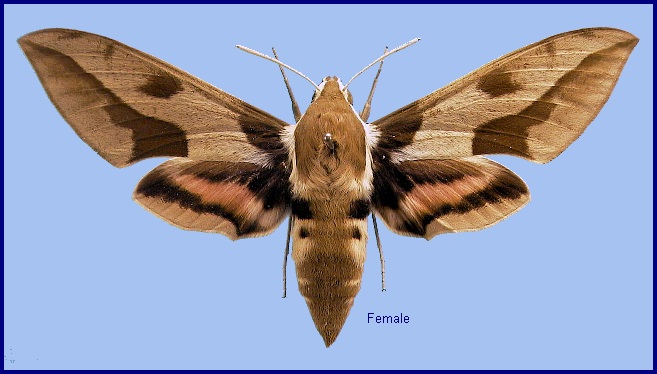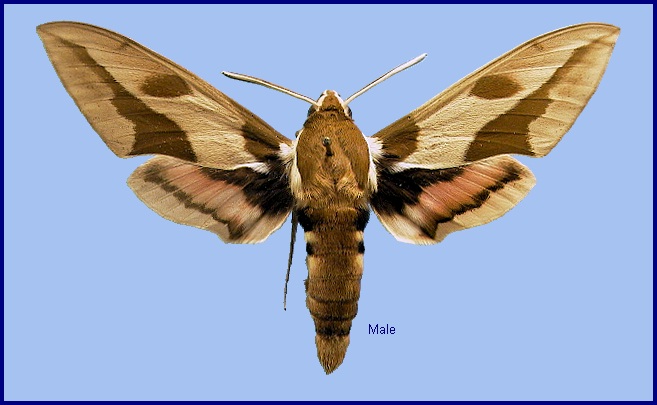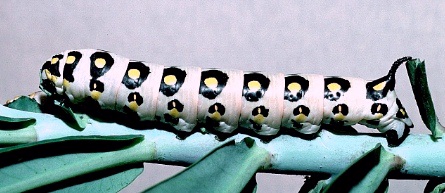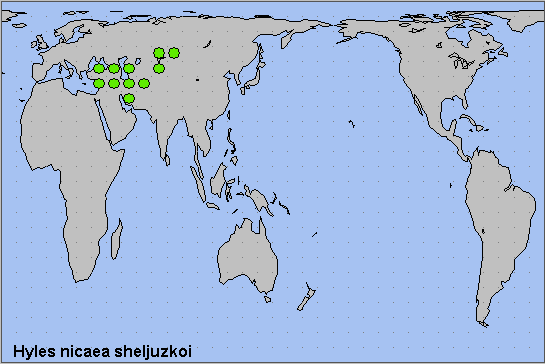

Celerio nicaea var. sheljuzkoi Dublitzky, 1928, Ent. Z., Frankf. a. M. 42: 38-40. Type locality: [Kazakhstan,] Djetissu Government (formerly Semireschje), Alma-Ata City (formerly Wernyi) [/Almaty].
Synonym. Celerio nicaea var. sheljuzkoi Dublitzky, 1928.
Synonym. Celerio nicaea libanotica Gehlen, 1932.
Note. Apart from size, this subspecies has no clear characters separating it from subsp. nicaea, so it may well be only a form. Hyles nicaea 'libanotica' is a large local form of subsp. sheljuzkoi from the Lebanon, Turkey and Iran, and certainly does not warrant subspecific status.
Wingspan: 90--110mm. Pale median band of forewing usually densely speckled with brown. Tegula without white upper fringe; abdominal sternites unicolorous; under surface of legs nearly as pale as upper surface. First protarsal segment with external spines not prolonged, the row doubled or trebled at base. Spines of comb of midtarsus little prolonged. Pulvillus present.
By far the largest subspecies of Hyles nicaea, but variable both in size and in the amount of dark speckling on the forewing, the most heavily dusted individuals being more common in Kazakhstan and China (Pittaway & Kitching, 2000). Some specimens even approach subsp. orientalis in the Transcaucasus region.
As with Hyles hippophaes bienerti, some specimens found above 2000m in Kurdistan and Iran may be considerably larger than normal.
Unknown in China, but Shchetkin (1975) described the ecology and biology of this subspecies in Tajikistan.
Occurs on dry, stony slopes at high altitudes -- up to 2800m in the Pamirs.
China: 21.vi (Yili area). Mongolia: 28.v (Khovd Province); 30.vi-10.vii (Khovd Province).
OVUM: In French examples, pale green, slightly oval (1.4 x 1.6mm), shiny and smooth. Very similar in size and shape to that of Smerinthus ocellata. The coloration changes to green and gold prior to hatching.
LARVA: Full-fed, 100--120mm. Polychromatic: pale grey to black.
In France, the newly emerged larva is 5mm long and a rich canary-yellow in colour, with a brownish black tail horn. With feeding, the yellow coloration is soon replaced by apple-green. This primary colour persists into the second instar, during which longitudinal rows of black dots appear; the horn and ventral surface also become black. In the third instar the final coloration of most individuals develops: pale grey with dorso-lateral and ventro-lateral rows of black-ringed yellow or red eye-spots. The horn remains black and there is no red dorsal line. However, some larvae become totally black with red eye-spots and buff lateral patches; the amount of black pigmentation is very variable.
At first, the young larva rests along the midrib on the underside of a leaf, but growth is rapid and the large larva soon rests on the stem, where it is difficult to spot.

PUPA: 45--50mm. In French populations, yellowish brown with fine black outlines to the legs and antennae. Enclosed in a loosely spun yellow cocoon amongst dead leaves and litter. The overwintering stage.
Larval hostplants. Unknown in China, but recorded in Kazakhstan on Euphorbia esula (Dublitzky, 1928).
Unknown for China.
China: Xinjiang (Shihezi; Tacheng; Yili area, near Yining; Xiaerxili Natural Reserve, near Bole City, Bortala Mongol Autonomous Prefecture).
Mongolia: Khovd Province (Dzhungarian Gobi, 15-45km SW Bulgan, 1350-1500m; Altai Mountains, Bodonch River, 50km NE Uyench, 2000m; Bodonchiyn River basin, Hundiyn River valley, 1600m (46°06'N 92°30'E); Ikh-Khavtag-Nuruu Mts., near Zhugentijn spring, 2050m (45°04'N 92°12'E); Bajtag-Bogd-Uul Mts., Baruun-Khargaityn-Gol (River) Valley, 2000m (45°16'N 90°57'E)).
Lebanon (Zerny, 1933; Ellison & Wiltshire, 1939), northern Israel (Müller et al., 2005b), western Jordan (Müller et al., 2005a), southern and eastern Turkey (Hariri, 1971; Kemal & Koçak, 2016; Koçak & Kemal, 2018), northern Iraq (Wiltshire, 1957; Kemal & Koçak, 2018c), the northern Caucasus (Didmanidze, Petrov & Zolotuhin, 2013), southern Dagestan (Russia), the Republic of Georgia (Didmanidze, Petrov & Zolotuhin, 2013), Armenia (Didmanidze, Petrov & Zolotuhin, 2013 ;Wąsala & Zamorski, 2015), Azerbaijan (Didmanidze, Petrov & Zolotuhin, 2013; Snegovaya & Petrov, 2021), Iran (Ghassemi, Alemansoor & Alehossein, 2010; Lehmann & Zahiri, 2011), Turkmenistan (Danov & Pereladov, 1985; Dubatolov, [1999]), Uzbekistan (Danner, Eitschberger & Surholt, 1998; Toropov, Milko, Zhdanko & Evdoshenko, 2023), eastern and southern Kazakhstan (Dublitzky, 1984; Yakovlev, Dubatolov & Titov, 2013; Shovkoon, 2015; Toropov, Milko, Zhdanko & Evdoshenko, 2023), Kyrgyzstan (Kondratiev coll., NHMUK; Korb, 2018; Toropov, Milko, Zhdanko & Evdoshenko, 2023), the Pamirs (Derzhavets, 1984), Afghanistan (Daniel, 1971), western Mongolia (Yakovlev, Ustyuzhanin & Doroshkin, 2005; Yakovlev & Doroshkin, 2017) and western Xinjiang Province, China (Pittaway & Kitching, 2000). The above records (specimens in SACS; IZAS) confirm the presence of Hyles nicaea sheljuzkoi in northwestern China.
Also, southwestern China (Xizang Province/Tibet) as subsp. lathyrus (Walker, 1856).

Holarctic; western Palaearctic region. Pleistocene refuge: Polycentric -- Syrian, Iranian and Turkestan refugia.
 Return to Sphingidae of the Eastern Palaearctic species list
Return to Sphingidae of the Eastern Palaearctic species list